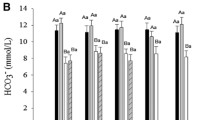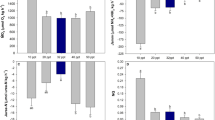Summary
-
1)
The following variables were measured in the haemolymph ofHelix pomatia, during periods of anoxia lasting up to 45 h and during recovery in air after 24 h of anoxia:d-lactate, succinate, propionate, acetate, Na+, K+, Ca2+, Mg2+, Cl−, protein, total osmolarity.
-
2)
d-lactate and succinate appear in the haemolymph immediately after the onset of anoxia and may reach concentrations of 60 and 40 mM, respectively. In the period 10 to 30 h following the onset of anoxia the two endproducts accumulate in the haemolymph at approximately the same rate. Propionate is not formed. Acetate may occur in the liver but its concentration is unrelated to the duration of anaerobiosis.
-
3)
Complete recovery after 24 h of anoxia takes a further 24 h. Changes in the concentration ofd-lactate and succinate suggest that these two end-products are metabolized in the liver.
-
4)
No significant changes of Na+, Cl− and protein occur during anoxia, suggesting that haemolymph volume remains more or less constant. However, the concentration of K+ in the haemolymph increases up to 3-fold.
-
5)
Ca2+ increases at a rate which corresponds to the rise ofd-lactate and succinate concentrations. Mg2+ shows only a modest increase and remains constant after 10 h of anoxia.
-
6)
Solute activity during anoxia increases initially, from an average of 160 to 270–280 mOsm, and then drops to approximately 220 mOsm. After 40 h of anoxia the difference between solute activity and concentration of all measured solutes amounts to approximately 160 mM.
-
7)
In the haemolymph of anaerobic snails the activity of Ca2+ is reduced by up to 60% but this is not sufficient to account for the reduction of total solute activity.
-
8)
In a buffer system resembling the haemolymph of anaerobic snails (containing 50 mM NaCl, 60 mM Ca2+, 60 mMd-lactate, 40 mM succinate, pH 6.9) the haemocyanin ofH. pomatia displays a negative Bohr shift (Δlogp50/ΔpH-0.14) with respect to aerobic haemolymph (pH 7.8) over the whole\(P_{O_2 } \) range considered. Cooperativity is identical under both conditions.
-
9)
It is concluded that none of the speculations so far advanced concerning mechanisms which might control the flow of metabolites along the major pathways of anaerobiosis, can completely explain the responses ofH. pomatia to anoxia.
Similar content being viewed by others
References
Bradford MM (1976) A rapid and sensitive method for the quantitation of microgram quantities of protein utilizing the principle of protein-dye binding. Anal Biochem 72:248–254
Brix O, Lykkeboe G, Johansen K (1979) Reversed Bohr and Root shifts in haemocyanin of the marine prosobranch,Buccinum undatum: Adaptation to a periodically hypoxic habitat. J Comp Physiol 129:97–103
Brown EB, Goott B (1963) Intracellular hydrogen ion changes and potassium movement. Am J Physiol 204:765–770
Burton RF (1965) Sodium, potassium, and magnesium in the blood of the snail,Helix pomatia L. Physiol Zool 38:335–342
Burton RF (1965) Buffers in the blood of the snail,Helix pomatia L. Comp Biochem Physiol 29:919–930
Burton RF (1976) Calcium metabolism and acid-base balance inHelix pomatia. In: Davies PS (ed) Perspectives in experimental biology. Pergamon Press, Oxford New York, pp 7–16
Burton RF (1977) Haemolymph calcium inHelix pomatia: Effects of EGTA, ganglion extracts, ecdysterone, cyclic AMP and ionophore A 23187. Comp Biochem Physiol 57C:135–137
Burton RF, Jaufeerally FR (1976) The mobilization of calcium and bicarbonate by raised concentration of potassium in the haemolymph of the snail,Helix pomatia. J Exp Biol 64:603–614
Cannan RK, Kibrick A (1938) Complex formation between carboxylic acids and divalent metal cations. J Biol Chem 124:2314–2320
Dexheimer L (1951) Beiträge zum Kalkstoffwechsel der Weinbergschnecke (Helix pomatia L.). Zool Jahrb Abt Allg Zool Physiol Tiere 63:129–152
Dotterweich H, Elssner E (1935) Die Mobilisierung des Schalenkalkes und die Reaktionsregulation der Muscheln (Anodonta cygnea). Biol Zentralbl 55:138–163
Dugal LP (1939) The use of calcareous shells to buffer the products of anaerobic glycolysis inVenus mercenaria. J Cell Comp Physiol 13:235–251
Ebberink RHM, DeZwaan A, Wijsman TCM (1976) Regulation of the phosphoenolpyruvate branchpoint by the adenylate energy charge inMytilus edulis. Biochem Soc Trans 4:444–447
Gäde G, Wilps H, Kluytmans JHFM, Zwaan A de (1975) Glycogen degradation and endproducts of anaerobic metabolism in the fresh water bivalveAnodonta cygnea. J Comp Physiol 104:79–85
Gawehn K, Bergmeyer HU (1974) D[(−)-Lactat. In: Bergmeyer HU (ed) Methoden der enzymatischen Analyse. Verlag Chemie, Weinheim/Bergstraße, pp 1538–1541
Hochachka PW, Mustafa T,(1972) Invertebrate facultative anaerobiosis. Science 178:1056–1060
Hoffmann KH, Mustafa T, Jørgensen JB (1979) Role of pyruvate kinase, phosphoenolpyruvate carboxykinase, malic enzyme and lactate dehydrogenase in anaerobic energy metabolism ofTubifex sp. J Comp Physiol 130:337–345
Holwerda DA, Zwaan A de (1973) Kinetic and molecular characteristics of allosteric pyruvate kinase from muscle tissue of the sea musselMytilus edulis L.. Biochim Biophys Acta 276:296–306
Johnston W, James TW, Barber AA (1967) Oxygen binding characterstics of lobster haemocyanin and its subunits. Comp Biochem Physiol 22:261–271
Klotz IM, Schlesinger AH, Tietze F (1948) Comparison of the binding ability of haemocyanin and serum albumin for organic ions. Biol Bull 94:40–44
Kluytmans JH, Veenhof PR, Zwaan A de (1975) Anaerobic production of volatile fatty acids in the sea musselMytilus edulis L. J comp Physiol 104:71–78
Konings WN, Van Diel R, Van Bruggen EFJ, Gruber M (1969) Structure and properties of haemocyanins. V. Binding of oxygen and copper inHelix pomatia haemocyanin. Biochim Biophys Acta 94:55–66
Mangum CP (1980) Respiratory function of the haemocyanins. Am Zool 20:19–38
Mangum CP, Lykkeboe G (1979) The influence of inorganic ions and pH on oxygenation properties of the blood in the gastropod molluscBusycon canaliculatum. J Exp Zool 207:417–430
Mustafa T, Hochachka PW (1973) Enzymes in facultative anaerobiosis of molluscs — III. Phosphoenolpyruvate carboxy kinase and its role in aerobic-anaerobic transition. Comp Biochem Physiol 45B:657–667
Schöttler U (1979) On the anaerobic metabolism of three species ofNereis (Annelida). Mar Ecol Progr Ser 1:249–254
Schöttler U, Schroff G (1976) Untersuchungen zum anaeroben Glykogenabbau beiTubifex tubifex M. J Comp Physiol 108:243–254
Spoek GL, Bakker H, Wolvekamp HP (1964) Experiments on the haemocyanin-oxygen equilibrium of the blood of the edible snail (Helix pomatia L.). Comp Biochem Physiol 12:209–221
Tilgner-Peter A (1957) Jahreszeitliche und klimatische Schwankungen im Calcium- und Phosphat-Gehalt des Blutes vonHelix pomatia L. Zool Jahrb Abt Allg Zool Physiol Tiere 67:365–372
Vannoppen-Ver Eecke T, Lontie R (1973) The effect of alkaline earth ions on the cooperativity of the oxygenation ofHelix pomatia haemocyanin. Comp Biochem Physiol 45B:945–954
Wardle CS (1978) Non-release of lactic acid from anaerobic swimming muscle of plaicePleuronectes platessa L.: a stress reaction. J Exp Biol 77:141–156
Wieser W (1978) The initial stage of anaerobic metabolism in the snailHelix pomatia L. FEBS Lett 95:375–378
Wieser W, Schuster M (1975) The relationship between water content, activity and free amino acids inHelix pomatia L.. J Comp Physiol 98:169–181
Wijsman TCM (1976) Adenosine phosphates and energy charge in different tissues ofMytilus edulis L. under aerobic and anaerobic conditions. J Comp Physiol 107:129–140
Williamson JR (1974) Succinat. In: Bergmeyer HU (ed) Methoden der enzymatischen Analyse. Verlag Chemie. Weinheim/Bergstraße, pp 1661–1666
Wilps H, Zebe E (1976) The end-products of anaerobic carbohydrate metabolism in the larvae ofChironomus thummi thummi. J Comp Physiol 112:263–272
Wolvekamp HP (1932) Untersuchungen über den Sauerstofftransport durch Blutpigmente beiHelix, Rana undPlanorbis. Z Vergl Physiol 16:1–38
Wolvekamp HP (1961) The evolution of oxygen transport. In: Macfarlane RG, Robb-Smith AHT (eds) Function of the blood. Academic Press, New York London, pp 1–72
Zwaan A de (1977) Anaerobic energy metabolism in bivalve molluscs. Oceanogr Mar Biol Ann Rev 15:103–187
Author information
Authors and Affiliations
Rights and permissions
About this article
Cite this article
Wieser, W. Responses ofHelix pomatia to anoxia: Changes of solute activity and other properties of the haemolymph. J Comp Physiol B 141, 503–509 (1981). https://doi.org/10.1007/BF01101473
Accepted:
Issue Date:
DOI: https://doi.org/10.1007/BF01101473




